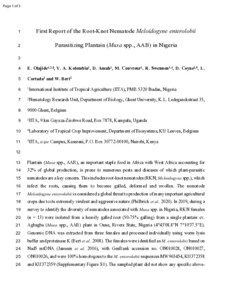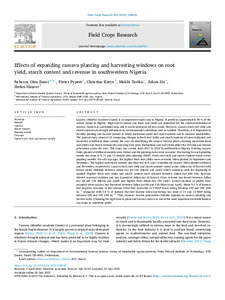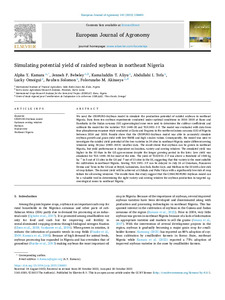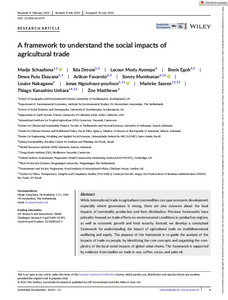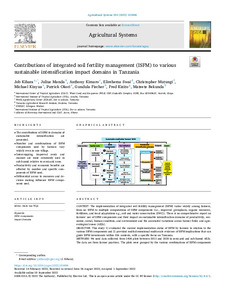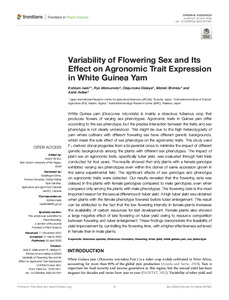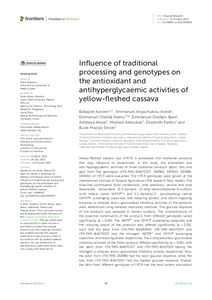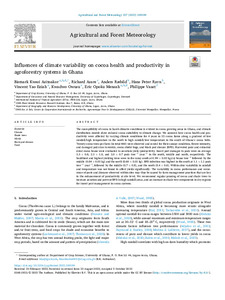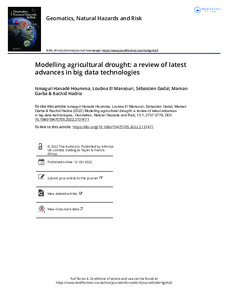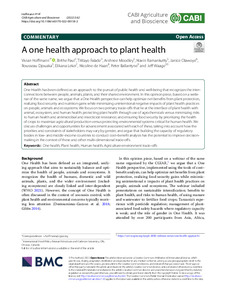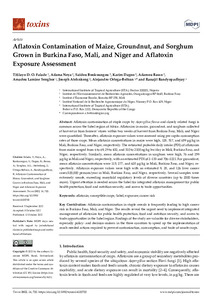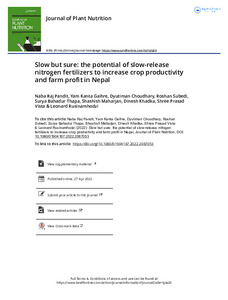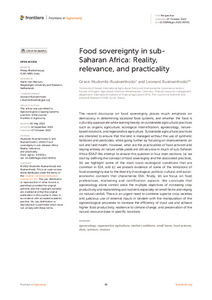Welcome to the International Institute of Tropical Agriculture Research Repository
Journal and Journal Articles: Recent submissions
Now showing items 381-400 of 5157
-
Comparative analysis of variation in African Bambara groundnut [Vigna subterranea (L) Verdc.] landraces assessed through seed traits
(2022-11)Bambara groundnut [Vigna subterranea (L.) Verdc.] originated from the African continent and plays social-economic roles in regions where it is consumed. This study examined 297 landraces of African Bambara groundnut from four African regions (West, Central, East, and Southern) to estimate the extent of diversity in each population, identify useful seed traits for differentiation in the population and estimate association among seed quantitative traits using eight qualitative and seven quantitative ... -
Cassava-maize intercropping systems in southern Nigeria: radiation use efficiency, soil moisture dynamics, and yields of component crops
(2022-07)Efficient utilization of incident solar radiation and rainwater conservation in rain-fed smallholder cropping systems require the development and adoption of cropping systems with high resource use efficiency. Due to the popularity of cassava-maize intercropping and the food security and economic importance of both crops in Nigeria, we investigated options to improve interception of photosynthetically active radiation (IPAR), radiation use efficiency (RUE), soil moisture retention, and yields of ... -
Understanding changes in cassava root dry matter yield by different planting dates, crop ages at harvest, fertilizer application and varieties
(2022-12-23)Cassava is a perennial crop that can adapt to periods of drought at different times in a growing season, which permits scheduling planting and harvest to develop production systems supplying roots continuously. However, farmers plant and harvest cassava at the onset of rains which creates glut and results in unattractive root prices. Thus, farmers need to understand how cassava varieties respond to different planting dates and crop ages at harvest to be able to use opportunities in income generation ... -
Effects of expanding cassava planting and harvesting windows on root yield, starch content and revenue in southwestern Nigeria
(2022-10-01)Cassava (Manihot esculenta Crantz) is an important staple crop in Nigeria. It provides approximately 80 % of the caloric intake in Nigeria. High starch content and fresh root yields are important for the commercialization of cassava. Cassava is a perennial crop, and it can be produced all year round. However, cassava fresh root yield and starch content are strongly influenced by environmental conditions such as rainfall. Therefore, it is important to identify planting and harvest periods to attain ... -
Simulating potential yield of rainfed soybean in northeast Nigeria
(2023-01)We used the CROPGRO-Soybean model to simulate the production potential of rainfed soybean in northeast Nigeria. Data from ten soybean experiments conducted under optimal conditions in 2016–2018 at Kano and Dambatta in the Sudan savanna (SS) agroecological zone were used to determine the cultivar coefficients and calibrate the model for the varieties TGX 1448–2E and TGX1951–3 F. The model was evaluated with data from four phosphorous response trials conducted at Zaria and Doguwa in the northern ... -
Leveraging digital tools and crowdsourcing approaches to generate high-frequency data for diet quality monitoring at population scale in Rwanda
(2022-01-07)Diet quality is a critical determinant of human health and increasingly serves as a key indicator for food system sustainability. However, data on diets are limited, scattered, often project-dependent, and current data collection systems do not support high-frequency or consistent data flows. We piloted in Rwanda a data collection system, powered by the principles of citizen science, to acquire high frequency data on diets. The system was deployed through an unstructured supplementary service data ... -
A framework to understand the social impacts of agricultural trade
(2022-08-30)While international trade in agricultural commodities can spur economic development especially where governance is strong, there are also concerns about the local impacts of commodity production and their distribution. Previous frameworks have primarily focused on trade effects on environmental conditions in production regions, as well as economic growth and food security. Instead, we develop a conceptual framework for understanding the impact of agricultural trade on multidimensional wellbeing ... -
Access to finance and rural youth entrepreneurship in Benin: Is there a gender gap?
(2022-01-27)Rural entrepreneurship is an important employment generation intervention for the fast-growing young labour force in developing countries. Many bottlenecks including access to finance impede rural youths from performing in their new ventures. This paper examines the impact of access to finance on rural youths' entrepreneurship in Benin using data from the second wave of the School-To-Work Transition Survey, involving over 900 youths. The paper employs the endogenous switching regression technique, ... -
Contributions of integrated soil fertility management (ISFM) to various sustainable intensification impact domains in Tanzania
(2022-12)CONTEXT The implementation of integrated soil fertility management (ISFM) varies widely among farmers, from no ISFM to multiple computations of ISFM components (i.e., improved germplasm, organic resources, fertilizers, and local adaptations e.g., soil and water conservation (SWC)). There is no comprehensive report on farmers' use of ISFM components and their impact on sustainable intensification domains of productivity, economic, social, human condition, and environment and the associated variations ... -
Variability of flowering sex and its effect on agronomic trait expression in white guinea yam
(2022-04-25)White Guinea yam (Dioscorea rotundata) is mainly a dioecious tuberous crop that produces flowers of varying sex phenotypes. Agronomic traits in Guinea yam differ according to the sex phenotype, but the precise interaction between the traits and sex phenotype is not clearly understood. This might be due to the high heterozygosity of yam where cultivars with different flowering sex have different genetic backgrounds, which mask the sole effect of sex phenotype on the agronomic traits. This study ... -
Influence of traditional processing and genotypes on the antioxidant and antihyperglycaemic activities of yellow-fleshed cassava
(2022)Yellow-fleshed cassava root (YFCR) is processed into traditional products that may influence its bioactivities. In this study, the antioxidant and anti-hyperglycaemic activities of three traditional products (lafun, fufu and gari) from five genotypes (IITA-TMS-IBA070337, 182961, 182962, 182986, 183044) of YFCR were evaluated. The YFCR genotypes were grown at the International Institute of Tropical Agriculture (IITA) research field, Ibadan. The bioactive constituents (total carotenoids, total ... -
Influences of climate variability on cocoa health and productivity in agroforestry systems in Ghana
(2022-12-15)The susceptibility of cocoa to harsh climatic conditions is evident in cocoa growing areas in Ghana, and climate distribution models show reduced cocoa suitability to climate change. We assessed how cocoa health and productivity were affected by varying climate conditions for 4 years in 23 cocoa farms along a gradient of low rainfall/high temperature in the north to high rainfall/low temperature in the south of Ghana's cocoa belts. Twenty cocoa trees per farm (in total 460) were observed and scored ... -
Misperceiving and misreporting input quality: implications for input use and productivity
(2022)Farmers in developing countries routinely misperceive or misreport input quality for various reasons, which introduces substantial measurement error in farm survey data. In this paper, we motivate and illustrate, both analytically and empirically, the inferential and behavioral implications of misperception and misreporting using a unique crop variety identification data from Nigeria. Using a non-parametric framework for testing the presence of measurement error, we show that crop variety ... -
Modelling agricultural drought: a review of latest advances in big data technologies
(2022)This article reviews the main recent applications of multi-sensor remote sensing and Artificial Intelligence techniques in multivariate modelling of agricultural drought. The study focused mainly on three fundamental aspects, namely descriptive modelling, predictive modelling, and spatial modelling of expected risks and vulnerability to drought. Thus, out of 417 articles across all studies on drought, 226 articles published from 2010 to 2022 were analyzed to provide a global overview of the current ... -
Aflatoxin biocontrol effectiveness in the real world-Private sector-led efforts to manage aflatoxins in Nigeria through biocontrol-centered strategies
(2022)Aflatoxins are toxic compounds produced by several Aspergillus species that contaminate various crops. The impact of aflatoxin on the health of humans and livestock is a concern across the globe. Income, trade, and development sectors are affected as well. There are several technologies to prevent aflatoxin contamination but there are difficulties in having farmers use them. In Nigeria, an aflatoxin biocontrol product containing atoxigenic isolates of A. flavus has been registered with regulatory ... -
A one health approach to plant health
(2022)One Health has been defined as an approach to the pursuit of public health and well-being that recognizes the interconnections between people, animals, plants, and their shared environment. In this opinion piece, based on a webinar of the same name, we argue that a One Health perspective can help optimize net benefits from plant protection, realizing food security and nutrition gains while minimizing unintentional negative impacts of plant health practices on people, animals and ecosystems. We ... -
Aflatoxin contamination of maize, groundnut, and sorghum grown in Burkina Faso, Mali, and Niger and aflatoxin exposure assessment
(2022)Aflatoxin contamination of staple crops by Aspergillus flavus and closely related fungi is common across the Sahel region of Africa. Aflatoxins in maize, groundnut, and sorghum collected at harvest or from farmers’ stores within two weeks of harvest from Burkina Faso, Mali, and Niger were quantified. Thereafter, aflatoxin exposure values were assessed using per capita consumption rates of those crops. Mean aflatoxin concentrations in maize were high, 128, 517, and 659 µg/kg in Mali, Burkina Faso, ... -
Slow but sure: the potential of slow-release nitrogen fertilizers to increase crop productivity and farm profit in Nepal
(2022-04-27)Reduction of nitrogen (N) input in cropping systems is critical to reduce environmental pollution and achieve sustainable development goals. Multi-location field trials for maize (n = 120) and rice (n = 84) were conducted across nine districts in Nepal during 2018 and 2019 to assess the potential of polymer coated urea (PCU) and urea briquette (UB) to increase agronomic N use efficiency (AEN), crop productivity and farm profits over conventional urea (CU). Nitrogen rates applied in PCU and UB ... -
Food sovereignty in sub-Saharan Africa: reality, relevance, and practicality
(2022-10-07)The recent discourse on food sovereignty places much emphasis on democracy in determining localized food systems, and whether the food is culturally appropriate while leaning heavily on sustainable agricultural practices such as organic agriculture, ecological intensification, agroecology, naturebased solutions, and regenerative agriculture. Sustainable agricultural practices are intended to ensure that the land is managed without the use of synthetic fertilizers and pesticides, while going further ...

